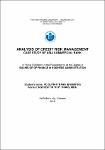| dc.contributor.author | Trang, Vo Quynh | |
| dc.date.accessioned | 2013-10-02T07:50:21Z | |
| dc.date.accessioned | 2018-06-07T01:58:43Z | |
| dc.date.available | 2013-10-02T07:50:21Z | |
| dc.date.available | 2018-06-07T01:58:43Z | |
| dc.date.issued | 2012 | |
| dc.identifier.uri | http://10.8.20.7:8080/xmlui/handle/123456789/594 | |
| dc.description.abstract | Concerns about distressing credit activities and vulnerable credit risk management system have been increased in current time. Due to United States’ troubled mortgage lending (2008) and European debt crisis (2010). In a developing country like Vietnam, domestic banks are unable to avoid the negative influence of global financial downturn. The big question is how to establish strong credit risk management in order to maximize their profit and to gain competitive advantage over rivalries but still reduce risk. This is where the research problems arise.
The core objective of this study is to provide the investigated bank with an insight of their credit risk management via proving the existence of problems in credit process and their impact
on financial health of the bank. Another important purpose is to recommend solutions to improve
the quality of credit risk control. The four research questions will be step by step guide the audience on how the objectives are achieved.
In order to give out defination and explanation or a sound base for discussion of problems and recommendations later, the thesis tried to revise literature review that is considered as the main secondary data. Furthermore, in order to elucidate existing issued lying in credit risk mamgement, the researcher also collected directly relevant information from Credit Information Center-CIC of National Bank. The data is input to statistical analysis in emphirical result and discussion of problems.
The analysis of both secondary and primary data shows that the bank has cope with demerits of quantitative method used in credit classification that impacts on the accuracy of reverse allocation and the effectiveness of controlling credit quality. Although positive performance represented by increasing profitablity conveys that that influence is insignficant and trivial to financial health of the bank, in long term future, as facing with heavy competition and unstable economy, it is time for the bank to make suitable modifications in credit classication. And according to requirements of National Bank via Decision 493/2005 and Basel II as well as recommendations of many experts, construction and application of internal credit rating together with the combination of qualitative and quantitative methods in credit classfication is the best solution to these problems. Therefore, the final chapter discusses about how to build effective
internal credit rating system in the bank. | en_US |
| dc.description.sponsorship | MBA. Nguyen Thi Thuy Trang | en_US |
| dc.language.iso | en | en_US |
| dc.publisher | International University HCMC, Vietnam | en_US |
| dc.relation.ispartofseries | ;022000857 | |
| dc.subject | Credit risk management | en_US |
| dc.title | Analysis of credit risk management "Case study of Asia commercial bank" | en_US |
| dc.type | Thesis | en_US |


